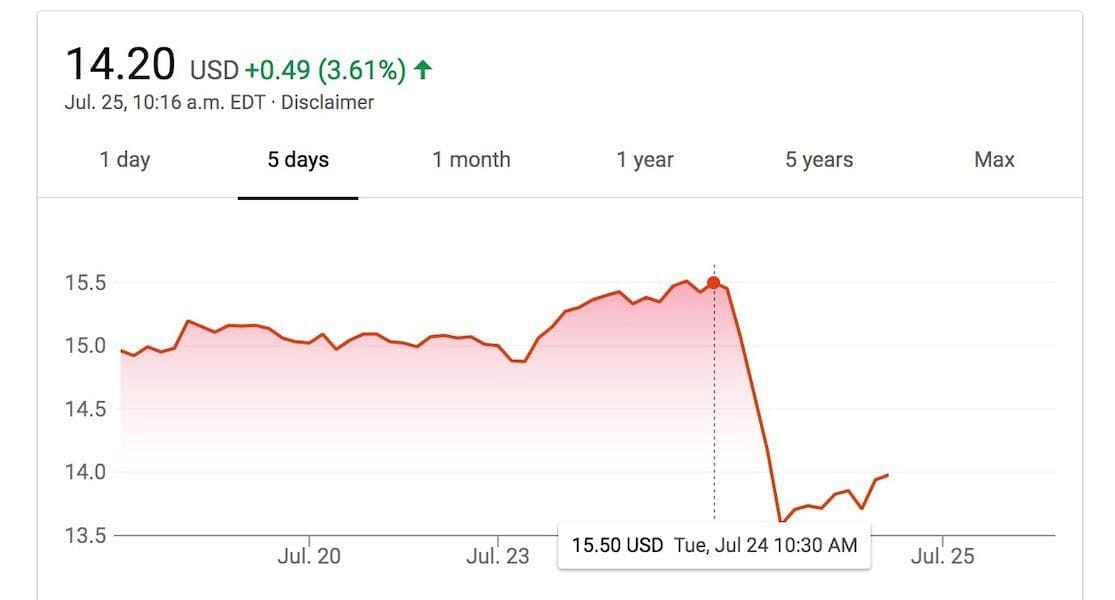
Stock prices of two major 3D printing companies dropped yesterday, but why?
There aren’t a lot of publicly traded 3D printer companies, but the largest two by far are 3D Systems and Stratasys, who have been on the exchanges for many years. Their stock values have been going up and down at times for years, with a huge boost in and around 2012-2014, and a precipitous crash in 2014-2015, with only a very limited recovery since.
Watching the stock values is an interesting game in which you can use them as a kind of thermometer of the public’s interest in 3D printing. Sometimes news arrives and causes the stocks to jump or drop, depending on how the news is interpreted by the public.
That may have happened yesterday.
Both 3D Systems and Stratasys stocks dropped a significant amount. 3D Systems fell from USD$15.45 to USD$13.58, a drop of 12% in only two hours. Similarly, Stratasys went from USD$21.30 to USD$19.51, a drop of 8.4% in the same period.
That’s significant. To put that in perspective, if 3D Systems dropped like this everyday, their billion dollar company would disappear completely in only a week.
The question is why this occurred. Usually such drops are a reaction by the market to untoward news, such as missing financial expectations, or some type of serious technical problem being revealed.
Also curious is that it seems only these two were involved. Two other prominent publicly traded 3D printer stocks, that of VoxelJet and ExOne, both seemed to sail through this situation without much change to their normally erratic pricing.
Honestly, I can’t seem to identify what specifically has generated this result. However, there is some fascinating speculation on Motley Fool by contributor Travis Hoium, who writes:
Shares of 3D Systems Corporation (NYSE: DDD) plunged as much as 12.1% in trading Tuesday, after the Trump administration opened up the possibility of 3D-printing guns. At the close of trading, shares were down 11.3% on the day.
The Trump administration’s State Department announced a settlement that will allow consumers to 3D-print guns like AR-15s for personal use. This will bypass all background checks and other regulations for guns.
3D-printed guns had been in a legal gray area, but that has ended for now with this announcement. But investors don’t seem to be happy that 3D printers will be associated with guns, which could bring on more regulation.
Could this be true? There are two sides to this question.
First, there is the technical side. 3D printed weaponry is barely possible, with typical results being guns of questionable functionality and especially reliability. Far better (actual metal) weapons are obtainable from the usual sources at vastly lower costs, so the proposition of a 3D printed gun is currently financially infeasible. No one is going to make these except for experimental purposes.
Yes, a non-metal weapon could theoretically pass through a security checkpoint, but these devices don’t work without ammunition, which must be metal, and are covered with detectable gunpowder residue. So security isn’t much of a concern.
In any case, every major center has hundreds or even thousands of metalworking machines that could make better weapons, so the prospect of making weapons by the public has been present for decades, and in better quality.
The second aspect of the question is whether the public understands these aspects of the situation, and it may be that people don’t, hence the reaction to the stock price.
It’s a bit laughable, because both 3D Systems and Stratasys produce high-cost industrial 3D printers, which would be the last choice of someone hoping to produce a weapon; there are plenty of far lower cost desktop 3D printers that could do the same work.
If the Motley Fool hypothesis is correct, it seems that the market is punishing only 3D Systems and Stratasys for this, which is really unfair. They both have nothing to do with this situation, and their equipment would likely not be involved in anyone making weapons.
However, it would appear that the public could be point at them, perhaps simply because they are big and well known.
Via Motley Fool

